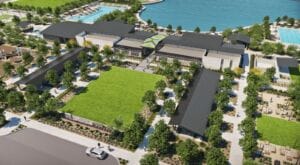Record e-commerce sales will drive more returns of goods bought online this holiday season than ever, stressing supply chains and increasing demand in the already tight industrial real estate sector, according to a new report from CBRE.
E-commerce returns this season could total as much as $70.5 billion, a 73 percent increase from the previous five-year average, according to CBRE research. This increase can be attributed to a historic rise in e-commerce sales triggered by the COVID-19 pandemic.
CBRE’s forecast, based on National Retail Federation data, estimates online purchases this holiday season (November and December) will reach $234.9 billion, a year-over-year gain of 40 percent. With an average return rate of 30 percent for online purchases, it’s easy to see why the overall number of returns will jump significantly.
“With a substantial percentage of holiday retail sales projected to be returned this season, the already stressed supply chain will be further pushed as companies deal with reverse logistics,” said Phoenix-based Senior Vice President Rusty Kennedy. “Many retailers that have focused on online sales through the pandemic are planning for large areas in their warehouses to handle and process these returns, which has led to many companies needing more space immediately in our region and nationwide and an increase in 3PL activity.”
He added,” After nine long months of the pandemic and the holidays upon us, the logistics and supply chain worlds have never been forced to adapt to consumer needs at a faster pace. And as there is no exact science behind what will be returned, retailers have to be flexible and move with the unpredictable current.”
Impact on Industrial and Logistics Real Estate
Optoro, a provider of returns technology and services for processing retail returns and CBRE’s partner for the report, estimates a reverse logistics supply chain requires, on average, up to 20 percent more space and labor capacity compared with forward logistics (the original order fulfillment process)—a conundrum given that industrial space is already incredibly tight:
• As of the third quarter, there were 22 U.S. markets with vacancy rates below the national average of 4.7 percent, according to CBRE.
• CBRE Economic Advisors estimates 1.5 billion sq. ft. of industrial space will be added in the U.S. in the next five years to meet growing demand.
• Many companies that currently occupy second-generation space are expected to upgrade to these newly constructed buildings, which will allow reverse logistics occupiers to lease a greater portion of Class B space. As much as 400 million sq. ft. of this space could be used to process returns in this five-year period.
Not all returns can be successfully discounted and put back in rotation. Optoro estimates that returns produce 5 billion pounds of waste in landfills annually.
“Retailers will have to meet this growing challenge in many ways,” John Morris, Industrial & Logistics and Retail Leader for CBRE, said. “More space will be required for distribution networks. However, cutting down on the overall return rate should be a paramount goal going forward. Technologies such as virtual sizing and augmented reality can help provide more accurate product assessments, allowing consumers to make more informed decisions and reduce returns. Innovations like this will help retailers limit their losses and cut product waste – a win-win for everyone.”
To download the report, click here.




